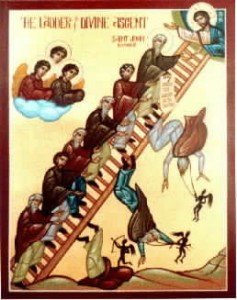 The 28th Step on John’s Ladder, which is PRAYER, can actually be divided into three different kinds of prayer: Spoken Prayer, Mental Prayer and Prayer of the Heart. I have already shared thoughts about Spoken Prayer.
The 28th Step on John’s Ladder, which is PRAYER, can actually be divided into three different kinds of prayer: Spoken Prayer, Mental Prayer and Prayer of the Heart. I have already shared thoughts about Spoken Prayer.
The second form of prayer is mental prayer, or prayer of the mind. This is when prayer goes from being something we do only at certain times of the day to being something we do inwardly throughout the day. Although it is thought of as the next level of prayer, it is something that even beginners can do. We can pray to God silently in our own words in almost any situation. But it takes time and experience in prayer to be able to learn the prayers of the Church by heart. The vast majority of Christians know the Lord’s Prayer, but there are other prayers that Eastern Christians should learn by heart, such as the Trisagion Prayer (i.e., Holy God, Holy Mighty One, Holy Immortal One, have mercy on us) and the Nicene Creed.
The Greek phrase Trisagion translates as “Thrice Holy” – as in this hymn God is described as holy in three different qualities. The hymn is of great antiquity and, perhaps, much older than the event assigned by the Greek Menology as connected to its origin. The tradition recounts that during the reign of Theodosius II (408-450), Constantinople was shaken by a violent earthquake, 24 September, and that while the people, the emperor and the Patriarch Procus (434-446) were praying for heavenly assistance, a child was suddenly lifted into midair, to whom all cried out Kyrie eleison (‘Lord, have mercy’). The child was then seen to descend again to the earth and in a loud voice he exhorted the people to pray: ‘Holy God, Holy Mighty, Holy Immortal’. The emperor then prescribed that it should be introduced into Christian worship. It is one of the oldest prayers of our Church and said at each service.
